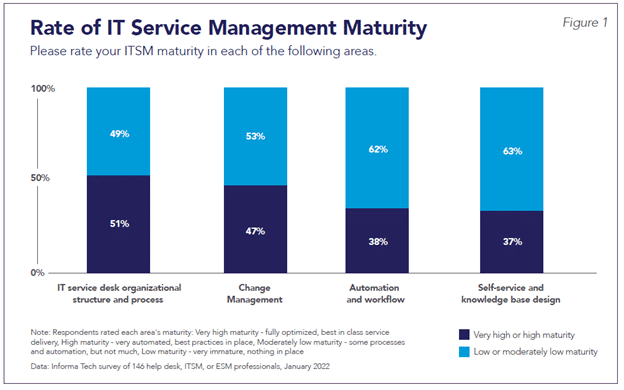As we assess the current state of IT Service Management (ITSM), one of the most obvious places to start is by asking those involved in the discipline how mature their practices and technologies truly are. ITSM is hardly a new niche in the world of IT, but it is one that has tended to evolve very organically at most organizations. So, mileage can vary, even at very large organizations, as to how far along they are in formalizing processes, standardizing technology, and in keeping that technology stack updated. We decided to tackle these questions in a recent market study conducted together with Information Week.
Nearly half of the organizations surveyed state that they are on the low end of the maturity scale, and only about 8% believe that they operate with a very high level of maturity where their ITSM software is fully optimized, and their IT group offers best-in-class service delivery through a formal program. At the same time, looking at the glass half full, the good news is that the majority-by-a-hair at 51% report a decent level of maturity with automation and at least some best practices in place.

Nevertheless, the results point to the fact that opportunities to improve performance and contain costs in a number of areas exist in the majority of organizations. To demonstrate those areas, we had respondents dive deeper into their maturity status by carving up their program into four major categories:
- IT service desk organizational structure and processes.
- Change management.
- Self-service and knowledge base design and
- Automation and workflow management.
We examine specific insights into each of these practice areas in the full study but if we look broadly at the maturity queries for each of these four, we see that organizations have made the most progress on the service desk structure and process development front, with 51% of them reporting high levels of maturity (Figure 1). Change management is close with 47% reporting high maturity—this is a crucial area since poor change management practices can lead to increased ticket volume, which perpetuates a vicious cycle of performance and cost woes.
ITSM Software Self-Service Portals & Knowledge Base Design
Meanwhile, automation and self-service functions remain areas for growth at most organizations, with 62% and 63% reporting low levels of maturity in these ITSM spheres, respectively. Achieving higher levels of maturity across the entire range will require organizations to address several challenges along the way. The study shows that some of the heaviest burdens ITSM programs face come by way of poorly optimized ITSM technology.
While management issues like a lack of resources or the inability to build a culture that drives self-service adoption certainly plague at least a quarter to a third of organizations, the biggest issues are platform-related. Tops among them are the heavy reliance on IT to administer the system, which was named by 44% of respondents, followed closely by a lack of automation, which was named by 41% of organizations. Additionally, 36% of organizations said one of their biggest challenges was integration and workflow management, yet another platform-related issue.
With the help of TeamDynamix, the IT department for MarketLab—a Michigan-based medical supply company—is changing how it operates, improving the maturity of its ITSM.
“We have realized improved end-user satisfaction, reduced administrative strain, optimized processes and gained better visibility with deep analytics,” explained Enterprise Systems Engineer Brendan Lesinski.
The simplicity and automation built into the TeamDynamix IT Service Management (ITSM) platform is saving time for MarketLab IT staff, and the easy visibility into key service data is helping IT leaders glean important insights into the root cause of incidents. As a result, MarketLab IT employees are working smarter and more efficiently, and they’re able to provide better service for the company’s employees.
MarketLab switched to TeamDynamix ITSM about a year ago, and Lesinski said the new system is “universally loved.”
“We wanted a tool that could be used as a service portal for potentially anything, as well as project management,” he said. “We found a lot of the other tools we were looking at were very hyper-focused on just ticketing or just project management, which is fine, but we wanted a tool that could do it all and be easily managed by people in facilities or our HR department while still giving us complete control of how married together those experiences are. We liked that the flexibility was there [in TeamDynamix] and we could manage the tool in a way that works best for us.”
Immediately, IT staff saved a great deal of time with the new system. The platform’s low-code, no-code design makes it very easy to make changes, such as adding new fields to forms. “What used to be a 45-minute effort now takes two minutes in TeamDynamix,” Lesinski said.
In addition, the system’s built-in automation has transformed MarketLab’s delivery of IT services. For instance, service tickets can be generated from email requests automatically. Lesinski calls this auto-creation feature “brilliant,” adding: “It has resulted in significantly less lost work.”
TeamDynamix has been very easy to use and manage, Lesinski notes, and the platform has made a huge difference for MarketLab’s IT team.
“I almost never think about the administrative aspect of the platform,” Lesinski said. “That, to me, is proof of its effectiveness. It just does what it’s supposed to do. I don’t have to babysit it like I do with other systems.”
Why Integration and Automation Matters for ITSM Software
By using an ITSM tool that includes integration and automation, you can free up your resources by automating the everyday, mundane tasks they normally have to complete before working on bigger projects – things like system name changes, resetting passwords, or granting certain permissions to software. All of these, and more, can be automated with workflows using iPaaS with your ITSM.
By combining iPaaS (integration platform as a service) with ITSM and PPM on a single platform you can automate both complex and simple tasks, as well as connect disparate systems throughout your organization.
If you choose a codeless platform for this, you get the added benefit of anyone being able to use these tools – not just IT. By allowing lines of business to create their own workflows you can free up your IT resources to work on larger projects and eliminate the logjam when it comes to integrations within your organization.
Nutrabolt Achieves Faster IT Support with Automated & Flexible ITSM Platform
“We had a help desk tool in place, but it was not purposefully built,” explained Mark Dittenber, Director of IT at Nutrabolt. “It was very generic, and there was no discipline in the use of it.”
Mark and his staff needed a highly flexible and customizable platform that could support new IT processes with automated workflows now, and into the future, as the company’s IT operations continued to mature “I liked the lightweight nature of TeamDynamix, as well as its ability to scale with our needs,” he said.
Mark and his team were able to implement TeamDynamix in a matter of weeks. They began with IT service management (ITSM) and have now expanded to include project management. All the configurations and automation are created without any technical resources on a no-code platform.
Within TeamDynamix, Mark and his Team established customized forms and automated workflows to create network accounts, assign rights and privileges to new teammates, submit and track service requests, request and approve IT changes, provision new devices and more. As they create new IT processes from the ground up, they’re also building out a knowledge base and a self-service portal. Having thoughtfully crafted processes in place — and the right enterprise service platform to support them — has already made a big impact in just a few months.
The improvement has been most noticeable in the onboarding of new teammates. “As we’ve formalized this process and improved our workflows, we’ve cut down on the number of follow-up calls required,” Dittenber said.
Improving the delivery of IT service by establishing more mature processes helps Nutrabolt become a highly nimble organization as the company continues to expand. “We’ve got a lot of work left to do, but we’ve made significant progress,” he concluded. “We’ve already seen good results, people have embraced these changes, and we’ll continue driving improvement and simplicity for the organization.”

